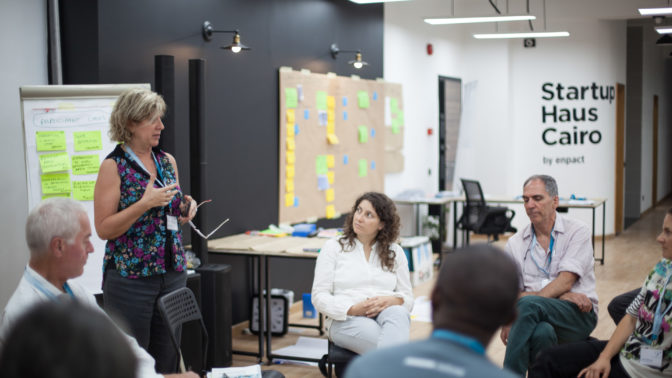A practical guide for (social) enterprises to become more gender-strategic
You have probably heard about gender gaps, like the gender pay gap or the gender data gap. Have you ever thought about gender gaps within your own organization and your work, too? Do you want to tackle them to become more gender-strategic in your operations? If your answers are yes and yes, this article is for you. In the following, you will be guided step-by-step through the general gender strategy process by gender-lens expert, Carolyne Kirabo, who you’ll get to know below.

1. Start with the ‘why’
To be successful in implementing gender strategies, it is crucial to first examine your organization’s internal thinking. Is everyone at the enterprise aware of existing gender inequalities? Do they know your enterprise has a responsibility in making the world more equal? You have the capacity to increase gender equality throughout your operations. Does everyone understand why a gender strategy is good for the organization? There is evidence that increasing inclusion and diversity in an organization is a strategic advantage. Inclusivity and diversity ensure that an organization is using perspectives for decision making that are a true reflection of the market in which its products and services operate. Gender bias and traditional norms serve the opposite. These reflections are critical in determining the why which then determines the whole process that follows.
2. Commitment is key – particularly from your leadership
When having understood why gender is a relevant topic for your organization, commitment to becoming gender-strategic should come easier. Commitment, in fact, is crucial for all further steps – especially from your leadership team, as they, generally, have the biggest influence on how the enterprise runs. Without your leadership’s commitment, the gender strategy process will not fully develop. Gender integration should not be just one of many topics but should be an adopted culture. If the board and senior leadership fairly represents women then the trickledown effect within the rest of the organization is smoother. If your staff are bringing up gender issues and the first thought as a leader is ‘how will that influence revenue’ or ‘there is no case for gender’ or ‘we are doing just fine’ then the cultural shift to increased inclusion and diversity becomes difficult. Be aware that once committed to the process, you will touch upon many different areas that will need adjustments, some more than others. Hence, you’ll need resources like time and money, maybe even a specific job position or the advice of an expert who can guide you along the way. But it is worth it!
3. Look for quick wins as you lay out the plan
Congratulations, you have committed to becoming more gender-strategic! Now where to start? This can probably seem overwhelming. Therefore, think like an investigator and ask the right questions to determine which steps can be taken in the short-, medium- and long-term. Find the spots and areas that are most obvious to you for quick wins:
- Using gender assessment tools, perform an analysis within the organization to determine areas with key gender gaps.
- Check whether existing gender inequalities are reflected in your organization’s internal structure and value chain, from suppliers and staff to the leadership level. Are women represented across all functions and levels? Do they have decision-making power?
- Think about your product or service as well as customers and users – what percentage of customers and users are women? Is the product designed with women’s needs in mind? Can they afford the product/service, and if not, could you maybe offer it on credit or installment payments?
- Once the gaps have been identified, develop an analytical process to determine why those gaps exist and more importantly develop possible solutions. An example could be that less than 50% of senior management positions are held by women and a possible solution could be for the human resource team to initiate leadership training for mid-level managers to encourage women to apply for internal senior positions.
- Make the process participatory – listening to the existing voices within the organization will create ownership.
4. Seek external expertise
Some steps might seem obvious to you and easy to take. However, some questions are maybe difficult to answer alone or entail several other issues. You might, therefore, consider getting external help by an expert who can look at your organization from a neutral perspective and who brings experience in the field. You can also make use of specific gender evaluation frameworks or assessment tools that help you map starting points or identify blind spots. There is plenty of knowledge out there you can tap in to, to improve your practices and strategies.
5. Get going and be patient
Be aware that changes will most likely not come over night. You will have identified pain points and thought of solutions that don’t work out. Let’s assume you have examined your organization and its value creation chain and want to attract female job applicants to hire more women. You face difficulties in finding the right female employees? Learn where they are and communicate in a more gender-sensitive way so that women trust you. You want to align your product or service according to women’s needs but don’t know whether they are even buying your product or to what extent? Start collecting gender-disaggregated data as a base for further steps in product development, marketing, and sales. Be patient as results may take time to be realized.
6. Don’t forget to evaluate and implement feedback loops
Steps are taken and results can be celebrated. Now, make sure to monitor whether your actions lead to the desired outcomes by implementing monitoring and evaluation structures. If your focus lies on your product/service or female customers, do your market research and involve the users in your product design so they receive the best product. Besides considering your target group in the process, also don’t forget the gender diversity in your own organization by building in feedback loops with your female employees. Be open to different angles, perceptions, and experiences!

This guide is to make you curious about gender strategies and the potential they could have, not only for your organization. Once you understand the opportunities they bring and you’re committed to contributing to more gender equality through your work, you can start taking small steps. You don’t need to do this on your own, there are experts and information available to help guide you. Follow the steps roughly or do it your own way but go on the journey and see what positive change it will bring. If you’d like, we’d love to hear from your experiences!
This article was written based on an interview with Carolyne and summarizes her recommendations.


